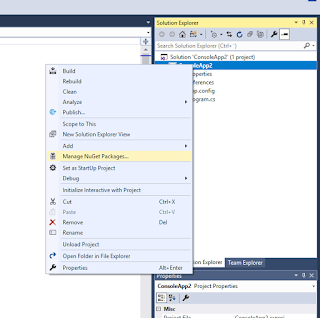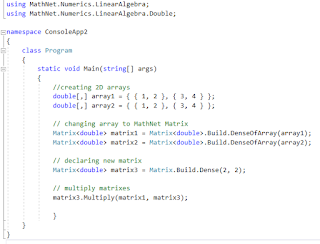The array is not exactly matrix. You can't make any mathematical operations on it. You can although make operations on the elements of the matrices. Of course to multiply two arrays with each other you can write your own scripts, but fortunately (like always ;) ) somebody already make it. You will find many math libraries allowing to implement algebraic operations. In this post I will show how to install in your VS one of them. I will be using NuGet packages, which by default you will find in your VS 2017 community.
First create new project and go for the solution explorer window. Right click on ProjectName and go for Manage NuGet Packages.
Install MathNet numeric, go back to your c# code. Everything is now ready to start using MathNet library.
https://www.mathdotnet.com/
Initialize two arrays of size 2x2 and tr to multiply them using MathNet.
First create new project and go for the solution explorer window. Right click on ProjectName and go for Manage NuGet Packages.
The Nuget will open. Please click browse in the left top, type mat and search for mathematical libraries.
https://www.mathdotnet.com/
Initialize two arrays of size 2x2 and tr to multiply them using MathNet.
Remember about adding library by typing:
using MathNet.Numerics.LinearAlgebra ;
in heading of the code



Comments
Post a Comment